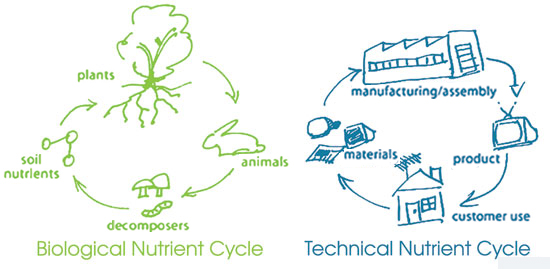Multi-Attribute Certification Pinpoints True Sustainability
The Concept Behind the Cradle to Cradle Movement
The phrase “cradle to cradle” itself was coined by Walter R. Stahel in the 1970s. The current model is based on “The Intelligent Product” initiated by Michael Braungart and colleagues at the Environmental Protection Encouragement Agency (EPEA) in the 1990s. In 1992, William McDonough and Dr. Michael Braungart published The Hannover Principles: Design for Sustainability. In 2002, they published Cradle to Cradle: Remaking the Way We Make Things, encapsulating a journey of discovery about materials as either biological or technical nutrients. In their cradle to cradle model, technical nutrient refers to a material or product that is designed to be returned to the industrial metabolism from which it came. Biological nutrients are materials or products that are designed to return to the biological cycle to be consumed by microorganisms in soil and other animals.
This concept that everything is “food” or a resource for something else is a core tenet of the Cradle to Cradle design philosophy. With conventional use and consumption come waste—and a lot of it. The U.S. alone generates approximately 254 million tons of municipal solid waste. Building-related construction and demolition (C&D) debris amounts to an additional 160 million tons per year. Cradle to Cradle proposes that we don't have a waste problem, we have a design problem. If we design intelligently from the start, we don't need to think in terms of waste, contamination, or scarcity. Good design would allow for abundance and endless reuse—elegant solutions. In addition, the Cradle to Cradle approach strives for eco-effectiveness or rather, doing more good instead of reducing and eliminating with the goal of being less bad. Cradle to Cradle co-founder Dr. Michael Braungart points out that mankind strives to make a positive impact both economically and socially, but when it comes to the environment, we strive for “zero”—net zero, zero waste, etc.—and zero is not a terribly inspiring goal. The Cradle to Cradle approach suggests that, when it comes to the making of things, mankind can go well beyond zero to have a positive, restorative, beneficial impact on the environment.
The Cradle to Cradle design ideal then is a world that is not resource constrained, where the concept of waste does not exist, where resources can be reused infinitely, and consumption is sustainable. All materials will be safe and healthy because they have been designed knowing the metabolism they will feed, with safe and healthy ingredients. Greenhouse gas pollution is addressed through commitments to make products with clean, renewable energy and products that are produced in systems that are fair and equitable to all stakeholders.
Development of the Certified Products Program
Following the publication of Cradle to Cradle: Remaking the Way We Make Things, McDonough and Braungart began working with clients to apply these concepts to product design in their consulting firms, McDonough Braungart Design Chemistry (MBDC) and EPEA. In 2005, MBDC first used the Cradle to Cradle Certified logo as recognition of achievement in design and production. Over the years it evolved and in 2010, in order to scale the certification globally and make it available to the public, McDonough and Braungart gifted the Certified Products Program to the Cradle to Cradle Products Innovation Institute. The Institute is an independent, non-profit, third-party verifier that administers two versions of the program—the legacy version 2.0 from MBDC and a new version 3.0 released in November 2012.
“The Institute's formation creates access for anyone to find out about the certification,” says Bridgett Luther, president of the Institute and former director of the California Department of Conservation. “The program and the process are completely transparent.”
The Institute also vets and trains accredited assessment bodies that use the program to assess their clients' products. The assessors submit assessment summaries to the Institute for verification and a certificate is issued if the product meets the requirements. An independent Certification Standards Board is the main governing body for the program. It reviews the quality standard criteria, makes revisions, additions, and changes as necessary to maintain the integrity and viability of the program.
 Image © 2013 MBDC |









